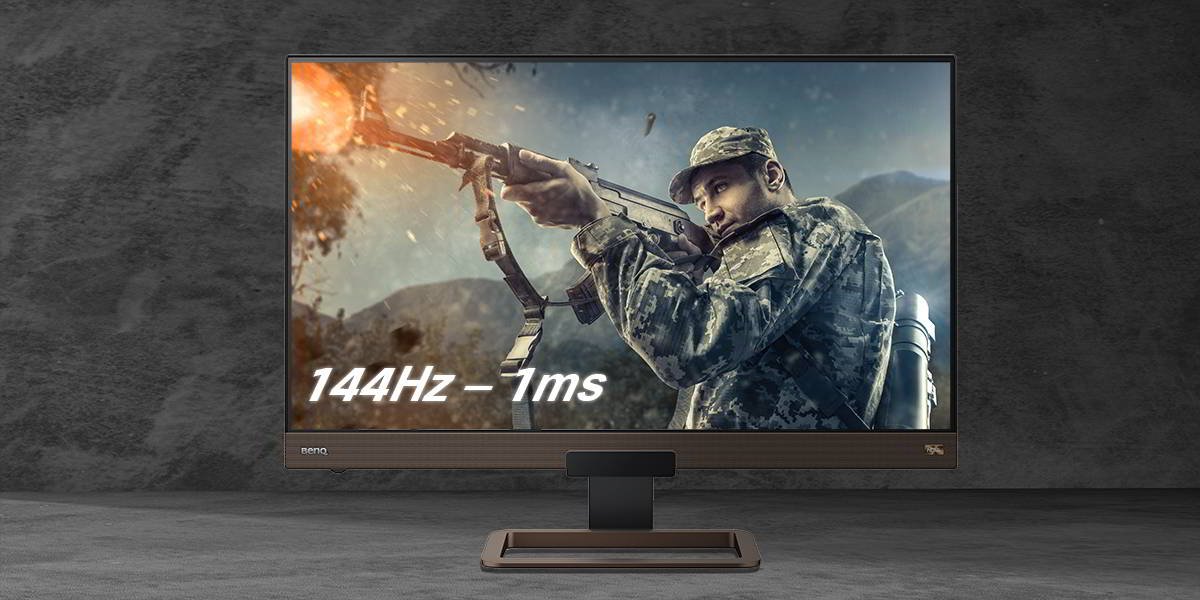

To get the best gaming monitor performance, response times need to lower in relation to rising refresh rates. That’s why 144Hz panels should be as close to 1ms as possible.

For gaming monitors, high framerates and low latency come in as must-haves. With ever-more powerful hardware, high framerates become possible in games, leaving the old 60Hz standard behind. Increasingly, 120Hz, 144Hz, and even 240Hz refresh rates (or framerates) have begun to proliferate. The popularity of competitive gaming and e-sports, where split-second response makes all the difference, has further reinforced the emphasis on high framerates, trickling down to mainstream gaming. But framerates aren’t everything. A fast refresh panel with slow response times incurs considerable latency and even flicker or ghosting, which is why monitor makers strive to achieve the 144Hz and 1ms winning combo.
Technically speaking, high refresh rates or framerates for monitors are quite easy to achieve. As long as the circuitry and panel can take the right current, clock settings, and frequency, you’ll get that high number of frames per second. This is the “simpler” side of the equation. It’s why you can have a 60Hz TV with 80ms response time just as you do a 60Hz monitor with 1ms. It’s because of this dichotomy that refresh rates, determined by monitor clock speeds essentially, are almost entirely separate from response times. You can have a fast refresh/slow response monitor. All the more reason for you to be alert when shopping for a new gaming monitor.
Response times or monitor latency prove trickier. While refresh rates are controlled by technologies that have been around for well over a century (current and frequency regulation), response times go directly to the fundamental (and much more recent) technology that drives the panel itself. In other words, refresh rates relate to basic technology common to most electronic devices while response times are entirely display-specific. They’re based on far more intricate techniques of updating each pixel on the screen, a much more demanding feat than simply supplying a monitor with extra power.
You can see this easily in TVs, where 60Hz panels very effectively run 120Hz content by simply overclocking the panel refresh. It’s a simple solution, but whether it’s effective remains debatable. In any case, response times present a more formidable challenge, with no easy fix. To get 1ms response, manufacturers need to invest considerable resources in panel materials, processing, transistor quality, and of course power delivery. It’s not easy to do.
Because if you have a 144Hz panel with 10ms response, you’ll notice everything from terrible input lag to possible ghosting and artifacts. Such a monitor simply has clock speeds way too high for its responsiveness. It’s too fast for its own good, resulting in poor performance. You can’t have high framerates with slow response.
In the 60Hz-dominated era, you could get away with 12ms response times (grey to grey). The screen update would still seem reasonably smooth and responsive outside of ultra-twitchy first person shooters. But with 144Hz, even 8ms leads to some chop, which can be very noticeable to many observers.
In essence, the faster your refresh or framerate, the quicker your response must be. Sure, resolution and panel size also figure into the formula, but we don’t want to overcomplicate matters right now.
With a good 144Hz gaming monitor, you’re looking at 5ms and faster. There’s no room for negotiation or error here. If you see a cheap 144Hz unit and realize the response on it is stated as 8ms or not stated at all, walk away.
The gold standard for 144Hz and faster monitors is as near to zero latency as possible. Of course 0ms response isn’t feasible in this universe due to the laws of physics, but 1ms is definitely doable and many incoming technologies get close to zero – for example 0.2ms with select OLEDs.
But until those technologies mature, do stay on point when it comes to refresh rate and response time. For all gaming monitors you need to be at 5ms or less. While good on 60Hz gaming monitors, that kind of response is a must on 144Hz panels. Slow response on a fast panel creates rather bad input latency and may make your gaming unbearable. It’s not something you want, so please do the research on any monitor you plan to buy.
Based on feedback from competitive gamers and esports pros while leveraging BenQ’s legacy of high performance gaming monitors, we’ve created MOBIUZ. What is MOBIUZ? It’s defying conventional thinking and creating a new generation of gaming monitors that make every pixel count better.
Current MOBIUZ gaming monitors include the EX2710 and EX2510, or 27” and 25” respectively. For view-changing curved displays, look at the EX3415R and EX3501R. With every MOBIUZ screen you get up to 144Hz with 1ms MPRT and FreeSync Premium for super responsive gameplay and sharp visuals. All on IPS panels that let colors come to life from wide angles as you get close to the action and see every detail, helped along by real HDR. To deliver superb gaming audio, MOBIUZ offers the power of treVolo sound with a 2.1-channel, twin speaker and subwoofer design.
MOBIUZ monitors meet the demands of gamers that want fast and accurate response with a high degree of visual fidelity. Check out the MOBIUZ lineup now.
{{title}}
We will notify you when we have more.
We will send you an email once the product become available.Your email will not be shared with anyone else.
Sorry, our store is currently down for maintenance.We should be back shortly. Thank you for your patience!